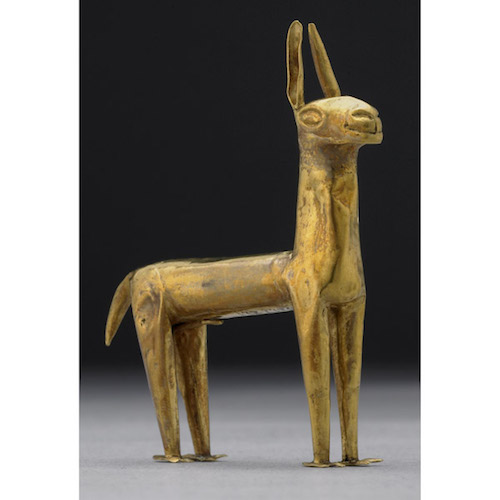

Inka. c. 1440-1533 C.E. Sheet metal/repoussé, metal alloys
While many ancient Andean art traditions favored abstract and geometric forms, Inka visual expression often incorporated more naturalistic forms in small-scale metal objects. This silver alloy corncob sculpture is one example of this type of object.
Completely identify:
Maize cobs
Inka empire, 1440-1533
Sheet metal/repoussé, metal alloys (silver\gold)
Ethnological museum, Berlin
Formal Analysis (elements and principles):
Inka metalsmiths combined silver and copper to mimic the internal and external components of actual corn
Art-making process (materials and techniques):
The Maize cob was made out of a mixture of copper and silver by Inka metalsmiths
It was made so that it retained the lifelike proportions of actual corn, and was thinner on the husk and thicker on the actual corn
The Maize cobs kernels were individually sculpted so that they are still visible, just like on actual corn
Content:
A life sized metal corn cob sculpture made of silver and gold.
Mimics the appearance of ripe corn ready to be harvested
Sculptural representation of Zae mays
Corn was a very important part of life, honoring the corn
Context\Audience:
Displayed in a metal garden in the courtyard of one of the most important Inka temples, the Qorikancha, in the capital city of Cuzco
Inka art (unlike many other Andean artistic traditions) favored naturalistic forms, as seen in this life like portrayal of corn
European invaders desired the gold and silver the Inkas had. Some of the earliest Spanish chroniclers record the placement of a garden composed of gold and silver objects among many of the offering and ritual spaces in the Qorikancha (including similar sculptures of the corn)
Plants and animals represented in the golden garden cannot grow and survive at every point in the empire, but only at certain altitudes. Maize grows up to a mid-range altitude,
metallic maize cobs would have represented one of the most important imperial foodstuffs, used for making the chicha (maize beer) consumed at feasts
Intended Function\Purpose:
The Maize cob was supposed to be a ritual offering performed by the Inca government or state religious officials
Many gold and silver objects as well as some textiles were used as offerings and sacrifices in the Inka religion
The rituals and offerings help retain Inka offical’s power (the Qorikancha’s garden reinforced the Inka’s divine right to rule)
All these offerings acted as symbols of the supernatural origin of the Inka’s in the Sun, and their control over the natural world as descendants from the most powerful deity
Artistic Innovation\Convention:
Inkan metalsmiths were able to sculpt silver, copper, and gold alloys into realistic animals and objects
Thematic and Cross Cultural Comparisons:
Power/Authority
Religion
Naturalistic artwork
Sources
https://www.khanacademy.org/humanities/ap-art-history/indigenous-americas/a/maize-cobs


